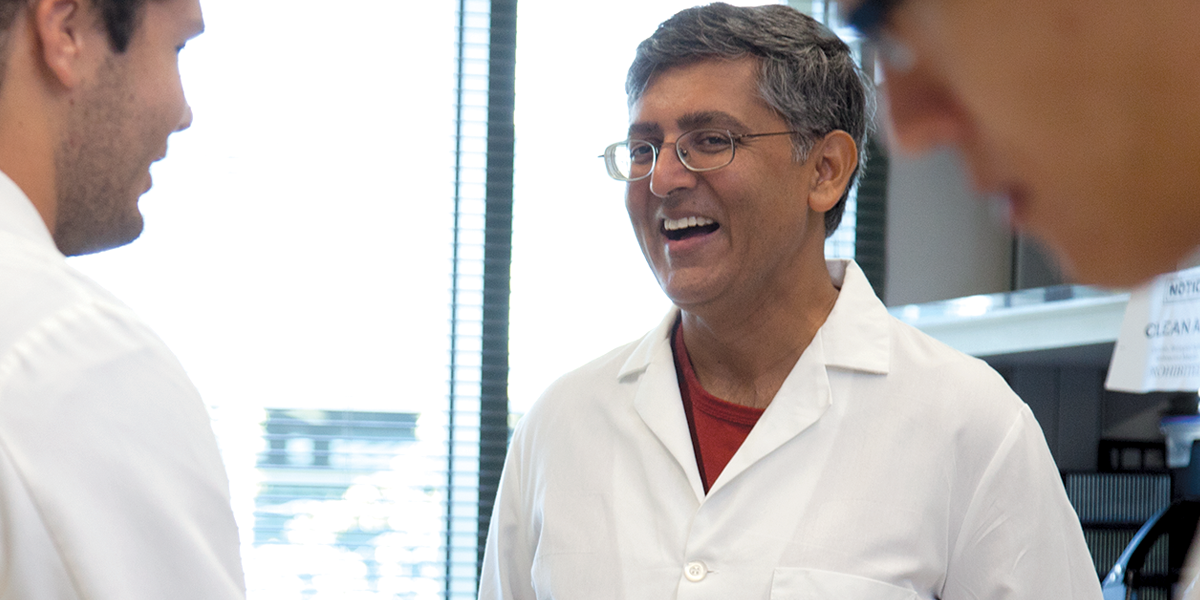The chromosome monitor
New possibilities for killing cancer cells emerge from studies of how chromosomes are parceled out during cell division.
Arshad Desai’s lab at Ludwig San Diego looks like a congress of microscopes. Small desktop types perch on benches. Larger, more elaborate contraptions, gussied up to peer more deeply into cells, crowd the side rooms, jostling for space beside computer displays, high-resolution cameras and elaborate stages for manipulating samples.
Desai and his team spend a good part of their days bent over these devices, probing a process fundamental to life: the parceling out of chromosomes during cell division. After chromosomes have duplicated, the two sister chromosomes remain together until they are yanked apart by the mitotic spindle, which places one sister into each of two daughter cells. This process, which ensures that each of our cells contains a single intact copy of our genome, often goes awry in tumors, resulting in cells with odd numbers of aberrant chromosomes—some missing, some broken, others just as dangerously duplicated.
Last year, Desai and his team helped uncover a molecular mechanism that controls when the sister chromosomes separate, and another that ensures that each new chromosome can attach to the spindle. Their findings could guide the design of new cancer-fighting compounds that selectively target such processes.
MAD connections
Not surprisingly, one of Desai’s most memorable scientific moments in 2014 occurred as he peered down a microscope.
He and his colleagues had been studying a complex of two proteins, MAD-1 and MAD-2. These checkpoint proteins monitor chromosomes, ensuring that they’re properly lined up, with the two matching sisters connected to the spindle in a way that allows for one to be pulled into each of the two daughter cells. “MAD-1 and MAD-2 send out a signal that stops the entire cell from dividing until each pair of chromosomes is properly connected,” says Desai.
Researchers can visualize proteins by tagging them with fluorescent molecular probes that light up under the right conditions. This technique has shown that MAD-1 and MAD-2 coat the structures that attach chromosomes to the spindle before cell division. But it has been less clear how they get there. MAD-1, it was known, attaches to MAD-2, but how does the MAD-1–MAD-2 complex then attach to the chromosome?
To find out, graduate student Mark Moyle had made precise mutations to a chief suspect in the scheme, a protein named BUB-1. When Moyle called Desai over to his microscope, Desai knew they’d found the answer. Where they should have seen MAD-1, they did not. “Normally you see this bright strip of protein enriched on the chromosome, and now it was completely gone,” says Desai.
With the attachment site on BUB-1 gone, MAD-1 disappeared from the chromosome. “That was the ‘aha’ moment,” says Desai, “the cleanest moment in this project.” MAD-1 was tacked onto the chromosome by a tethering protein, and that protein had to be BUB-1. “This connection is controlled by proteins that are targets in clinical therapies under development,” says Desai. By better understanding how all these proteins interact, researchers could develop drugs that disable a key mechanism in the molecular engines of cancer.
Desai carried out this research in a small worm, Caenorhabditis elegans. At barely a millimeter long, the worm is a lot easier to work with than mice or human cells. And when it comes to fundamental processes, such as cell division, humans are not much different from worms—there is evidence that BUB-1 operates similarly in people. Proteins Desai has helped identify as actors in cell division in worms and yeast are now seen as promising targets for cancer therapies.
“My whole career I have worked on these fundamental mechanisms,” says Desai. “But, at the same time, we want to be able to connect this understanding to cancer.”
The long view
Desai’s lab has a deliberately open floor plan, and his team shares space with those of other Ludwig researchers, including his wife and frequent collaborator, Karen Oegema. “People are always running into each other,” says Desai. “It drives people to do interesting stuff.”
Some of it involves other Ludwig researchers in San Diego as well, such as the head of Ludwig’s Small Molecule Discovery program, Andrew Shiau, who is working with Desai to develop compounds that target chromosome segregation. The idea is that such agents would disproportionately cripple rapidly dividing cancer cells, mangling their chromosomes enough to kill them or prompt their self-destruction.
Desai is also taking aim at other proteins, such as the components of the centromere, a protein complex that forms the foundation for assembling the structures that allow the spindle to grab onto the sister chromosomes and parcel them out to the two daughter cells. In February 2015, Desai’s lab published a study in yeast that clarifies the important role of the centromere protein CENP-A. The team showed how a small region of CENP-A stabilizes the centromere, allowing it to form on the same part of the chromosome generation after generation to ensure proper chromosome inheritance and secure the integrity of the genome.
Desai is currently testing compounds that target chromosome segregation to see if they might stop the deadly proliferation of cancer cells. Meanwhile, he continues to squint through his many lenses for the next fundamental insight into a defining process of life.
REFERENCES
Moyle MW, Kim T, Hattersley N, Espeut J, Cheerambathur DK, Oegema K, Desai A. A Bub1-Mad1 interaction targets the Mad1-Mad2 complex to unattached kinetochores to initiate the spindle checkpoint. J Cell Biol. 2014 Mar 3;204(5):647-57. doi: 10.1083/jcb.201311015. Epub 2014 Feb 24.
Folco HD, Campbell CS, May KM, Espinoza CA, Oegema K, Hardwick KG, Grewal SI, Desai A. The CENP-A N-tail confers epigenetic stability to centromeres via the CENP-T branch of the CCAN in fission yeast. Curr Biol. 2015 Feb 2;25(3):348-56. doi: 10.1016/j.cub.2014.11.060. Epub 2015 Jan 22.
